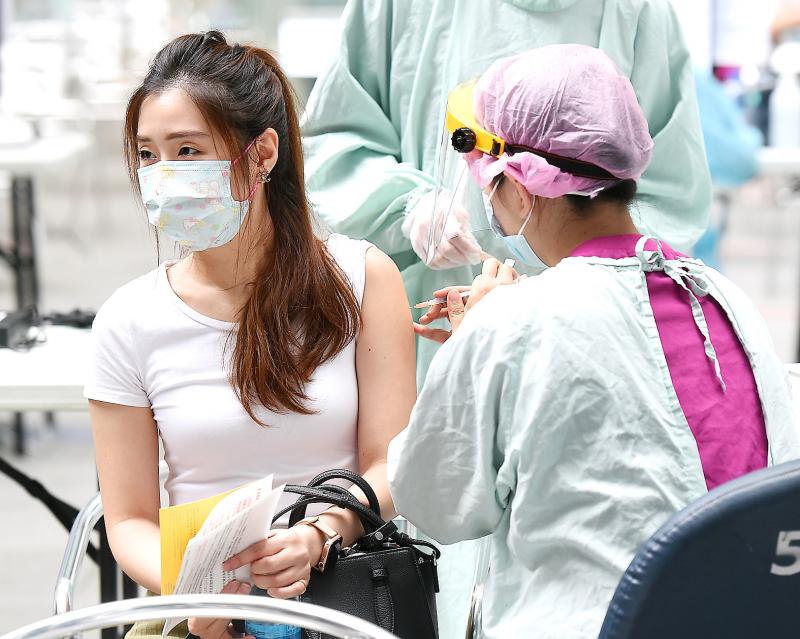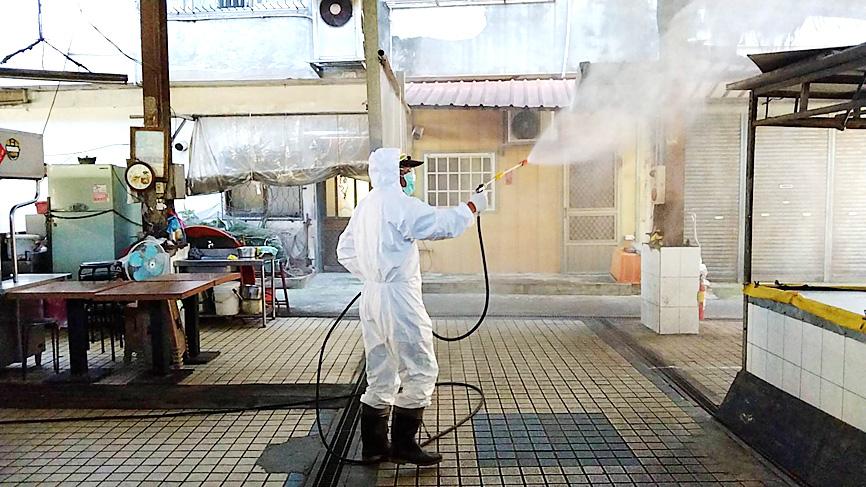The Central Epidemic Command Center yesterday reported 28 locally transmitted COVID-19 cases, the lowest number since the outbreak started in May.
The center also reported one death, a woman in her 70s, who had an underlying health condition. It also reported that the average age of COVID-19 deaths in the nation is 73, and that 90.1 percent had underlying health conditions.
Of the 28 local cases, 19 were female and nine were male, ranging in age from younger than five to older than 90, said Minister of Health and Welfare Chen Shih-chung (陳時中), who heads the center.

Photo: Chu Pei-hsiung, Taipei Times
Thirteen of the cases tested positive during quarantine or upon ending quarantine, he said.
Taipei reported 15 cases, followed by New Taipei City with five, Taoyuan with three and Miaoli County with two. Keelung, and Pingtung and Hsinchu counties reported one each.
The sources of 16 cases have been identified, while 11 cases are under investigation and the source for one was unclear, Chen said.

Photo courtesy of the Miaoli County Government via CNA
The center also reported three imported cases — one child who returned from the US, and two men who returned from the UK and Saudi Arabia.
Asked if the center was considering removing the level 3 COVID-19 alert on Monday next week for cities and counties other than Taipei and New Taipei City, Chen said the center has not made a decision, but that the restrictions on some businesses might be modified.
“The whole of Taiwan is within one-day traveling distance, so restrictions must be the same throughout the nation,” he said.
However, enhanced disease prevention measures could be implemented in hotspots, rather than by city or county, he added.
A new case linked to the Delta variant of SARS-CoV-2 has been confirmed in Pingtung County, but the person has been under isolation and poses little risk to the local community, he said.
The person likely contracted the disease from two earlier confirmed cases, Chen said.
A new case was also detected in expanded testing at Huannan Market (環南市場) in Taipei’s Wanhua District (萬華), bringing the total number of cases at the city’s three worst-affected markets to 232, he said.
Polymerase chain reaction (PCR) testing of 2,800 workers at Huannan Market is to be conducted tomorrow, while testing of 1,300 workers at the First Fruit and Vegetable Wholesale Market in Wanhua is to be conducted on Thursday.
Huannan Market, which is resuming operations today, has to follow six requirements — all workers have to present a negative PCR result to gain entry; workers have to wear face shields and masks; crowd capacity must be reduced to 50 percent; separating the flow of people moving between different floors; real-name registration; and health monitoring of all workers, the center said.
Of the 13,696 local cases reported from May 11 to Sunday, 2,712 people, or 19.8 percent, were considered severe cases, while 675 people died as a result, specialist advisory panel convener Chang Shan-chwen (張上淳) said.
Of the 675 deaths, the average age was 73 and 608, or 90.1 percent, had an underlying health condition, Chang said.
An analysis showed that the most common health conditions were hypertension, diabetes, cardiovascular disease, kidney disease, stroke, cancer and hyperlipidemia, he said, adding that the majority had more than one condition.

SECURITY: As China is ‘reshaping’ Hong Kong’s population, Taiwan must raise the eligibility threshold for applications from Hong Kongers, Chiu Chui-cheng said When Hong Kong and Macau citizens apply for residency in Taiwan, it would be under a new category that includes a “national security observation period,” Mainland Affairs Council (MAC) Minister Chiu Chui-cheng (邱垂正) said yesterday. President William Lai (賴清德) on March 13 announced 17 strategies to counter China’s aggression toward Taiwan, including incorporating national security considerations into the review process for residency applications from Hong Kong and Macau citizens. The situation in Hong Kong is constantly changing, Chiu said to media yesterday on the sidelines of the Taipei Technology Run hosted by the Taipei Neihu Technology Park Development Association. With

CARROT AND STICK: While unrelenting in its military threats, China attracted nearly 40,000 Taiwanese to over 400 business events last year Nearly 40,000 Taiwanese last year joined industry events in China, such as conferences and trade fairs, supported by the Chinese government, a study showed yesterday, as Beijing ramps up a charm offensive toward Taipei alongside military pressure. China has long taken a carrot-and-stick approach to Taiwan, threatening it with the prospect of military action while reaching out to those it believes are amenable to Beijing’s point of view. Taiwanese security officials are wary of what they see as Beijing’s influence campaigns to sway public opinion after Taipei and Beijing gradually resumed travel links halted by the COVID-19 pandemic, but the scale of

A US Marine Corps regiment equipped with Naval Strike Missiles (NSM) is set to participate in the upcoming Balikatan 25 exercise in the Luzon Strait, marking the system’s first-ever deployment in the Philippines. US and Philippine officials have separately confirmed that the Navy Marine Expeditionary Ship Interdiction System (NMESIS) — the mobile launch platform for the Naval Strike Missile — would take part in the joint exercise. The missiles are being deployed to “a strategic first island chain chokepoint” in the waters between Taiwan proper and the Philippines, US-based Naval News reported. “The Luzon Strait and Bashi Channel represent a critical access

Pope Francis is be laid to rest on Saturday after lying in state for three days in St Peter’s Basilica, where the faithful are expected to flock to pay their respects to history’s first Latin American pontiff. The cardinals met yesterday in the Vatican’s synod hall to chart the next steps before a conclave begins to choose Francis’ successor, as condolences poured in from around the world. According to current norms, the conclave must begin between May 5 and 10. The cardinals set the funeral for Saturday at 10am in St Peter’s Square, to be celebrated by the dean of the College